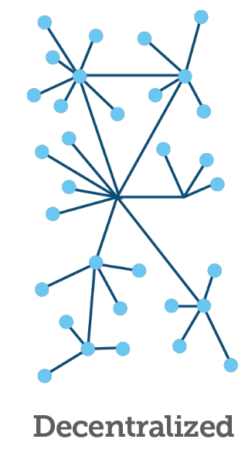How can Blockchain Technology Help Improve Food Safety
What Is Blockchain
The original blockchain was created by Bitcoin founder Satoshi Nakamoto to serve as the public ledger to record all Bitcoin transactions.

Blockchain – is a decentralized, shared log of data maintained on a network of computers, rather than a physical ledger. The primary purpose of blockchain is to record any transaction or movement of an asset. Therefore, it is a digital ledger of records that are organized in chunks of data called blocks.
The blocks are then linked with one another through a cryptographic (secure communications) validation. The linked blocks form an unbroken chain — a blockchain. It gives the network participants the ability to share ledger data. Each participant on the network can act as publisher and subscriber. Each participant can receive data and send data, and the data is synchronized throughout the network.
The main innovation of Blockchain is that it keeps all data in a sequence of “blocks,”  which are spread over a computer network of nodes. It is impossible for any user to change or remove data because: (i) There is no central authority; (ii) because copies of the ledger are stored on every node. Whatever is put on the blockchain is cast in stone.
which are spread over a computer network of nodes. It is impossible for any user to change or remove data because: (i) There is no central authority; (ii) because copies of the ledger are stored on every node. Whatever is put on the blockchain is cast in stone.
The main features of blockchain network include the ability of participants on each node to know where the products came from and how ownership changed over time. The blockchain provides a single place to determine the movement of goods. No participant can change a transaction after it is recorded. The history of all the transactions (including reversal of error) is transparent to all users, and therefore the system is tamper-evident.
IBM has published an EBook detailing the technology. The blockchain built by IBM is called Hyperledger Fabric, and the company is trying to promote it to various industries. It is eagerly trying to sell subscriptions to blockchain related services and their integration with the cloud business.
Coalition of Companies are Using Blockchain
Fortune magazine reported that Walmart and a number of other food giants (Unilever, Dole, Nestlé, Kroger, McCormick and Company, McLane Company, Driscoll’s, Tyson Foods, and Golden State Foods ) teamed up with IBM investigate how to utilize blockchain to improve the traceability of food and its ingredients.
According to Fortune magazine, Walmart ran a trial of blockchain utilization, in cooperation with IBM. In the first trial, they used blockchain to track the movement of pork in China.
In the second trial, they used blockchain to trace mangoes from Mexico. Tagged pallets of mangoes were traced through the blockchain. While manual tracing took almost a week, the software took a couple of seconds to show the results. In the event of a food pathogen outbreak, the difference between 6+ days and 2 seconds can be very significant.
Because of the success of these experiments, Walmart is now reaching out to other suppliers and retailers.
Examples of Use of Blockchain and its Benefits in Food Safety
 Food manufacturers and suppliers like the idea of simple, automated tracking system of important information (temperature, delivery dates, safety certificates, etc.) available instantly.
Food manufacturers and suppliers like the idea of simple, automated tracking system of important information (temperature, delivery dates, safety certificates, etc.) available instantly.
Another use of Blockchain technology is to utilize sensors data in warehouses and transportation. It can serve as proof that the products were all along handled at the right temperature.
Examples of Potential Impact on Recalls of Contaminated Foods
Blockchain can allow companies to trace their products in case of a recall due to contaminated product, and remove it promptly from the shelves. The ability to pinpoint within minutes, where contaminated product might be, can revolutionize food safety.
Blockchain can allow tracing a contaminated papaya, for example, to a farm of origin and find the location of existing products on the market. Retailers can instantaneously remove these products from the shelves.
The Blockchain technology can play a major role in the investigation of foodborne illnesses. For example, the outbreaks due to Salmonella in contaminated Maradol papayas imported from Mexico infected 251 people in 25 states. 79 of the infected people were hospitalized, and two deaths were reported. It took many months to identify the farms responsible for the outbreaks. If blockchain technology was in place and the origin of each papaya could be identified in seconds, the outbreak would have ended faster, with fewer victims.
Another example is the milk powder and buttermilk produced by Valley Milk Products (VMP) that presumably was contaminated with Salmonella. The VMP recall resulted in a subsequent ripple effect of recalls affecting over 30 companies. It included companies that bought products from VMP (first group), but also companies that used seasoning containing VMP products from the first group or products that were manufactured by a third party on lines where traces of the VMP were processed. If all parties involved were on a blockchain system, it could have taken less than a day to complete the recall saving most companies the trouble of going through the costly recalls.
Utilization in Food Fraud
In the Netherlands, Arc-net and PwC sign an agreement, using blockchain in the fight against food fraud. They are developing a supply chain authentication platform using blockchain in the cloud to allow food producers and retailers to assure the origin and authentication of their products.

Hurdles
Technology in early stages of development and faces some hurdles ranging from technological hurdles to legal, economic, and regulatory. All trials to date were on a very small scale. It must be adequately evaluated before any widespread adoption.
A technological hurdle is the cost of data storage in blockchain and the limited number of transactions per second. However, this does not stop innovators from building on this promising solution.
A main challenge is how and who will be responsible for the governance of the technology. The regulatory framework for the technology is uncertain and unpredictable. Will the technology be regulated by the authorities? Will they accept the technology?
The full benefit of blockchain will not be realized without widespread adoption by the industry. This is difficult due to the need to integrate blockchain into the industry’s countless number of information systems, lacking a common communication standard.
Despite these hurdles, the blockchain technology had made several baby steps and is turning into giant strides.
Summary
Blockchain is an exciting new technology that can revolutionize food safety. It can resolve many critical issues affecting food safety such as prevent unnecessary recalls, avoid cross-contamination, prevent foodborne illnesses, eliminate waste, simplify recalls, and save money. However, there are still some impediments that need to be overcome before widespread adaptation in food safety.
